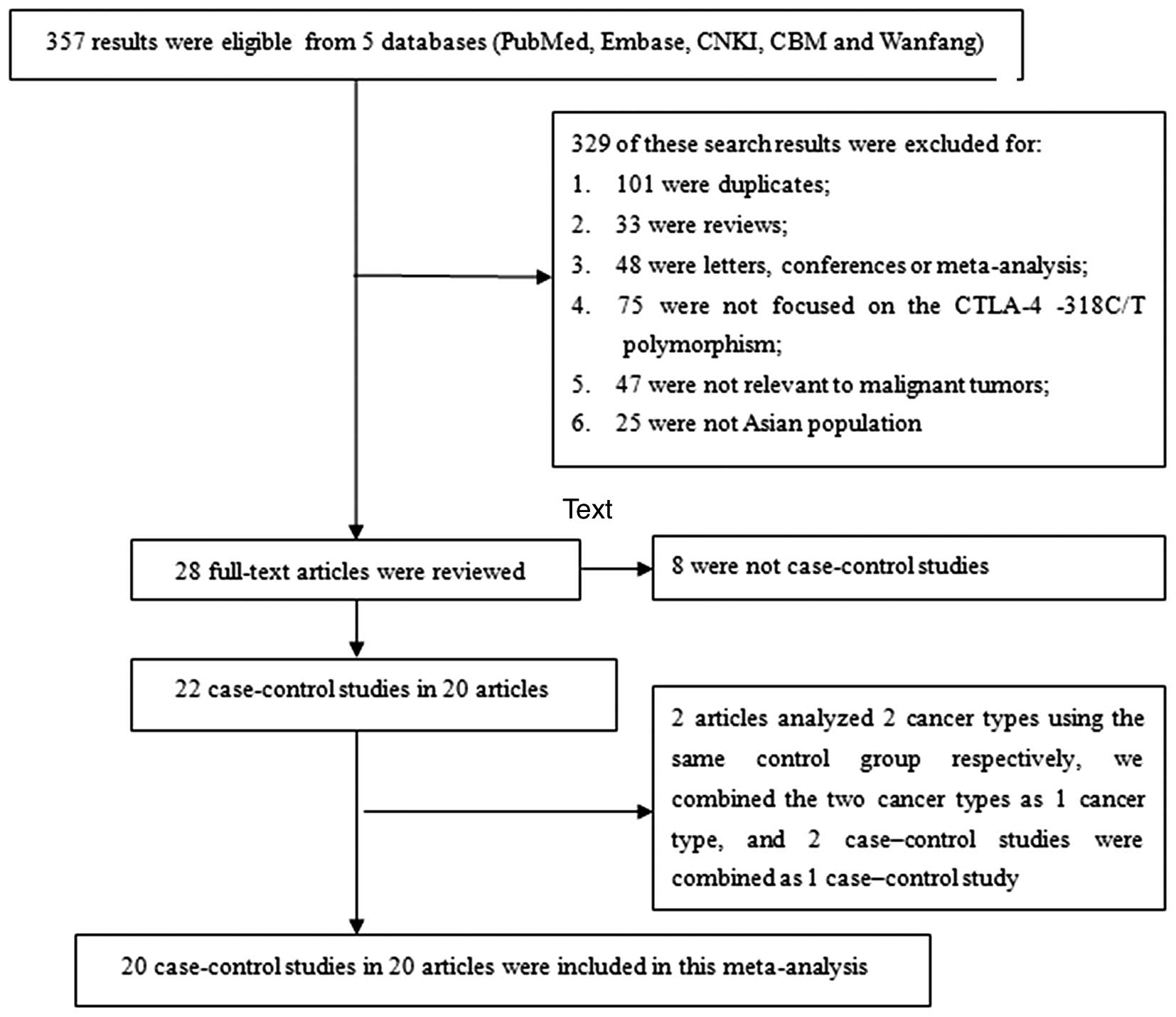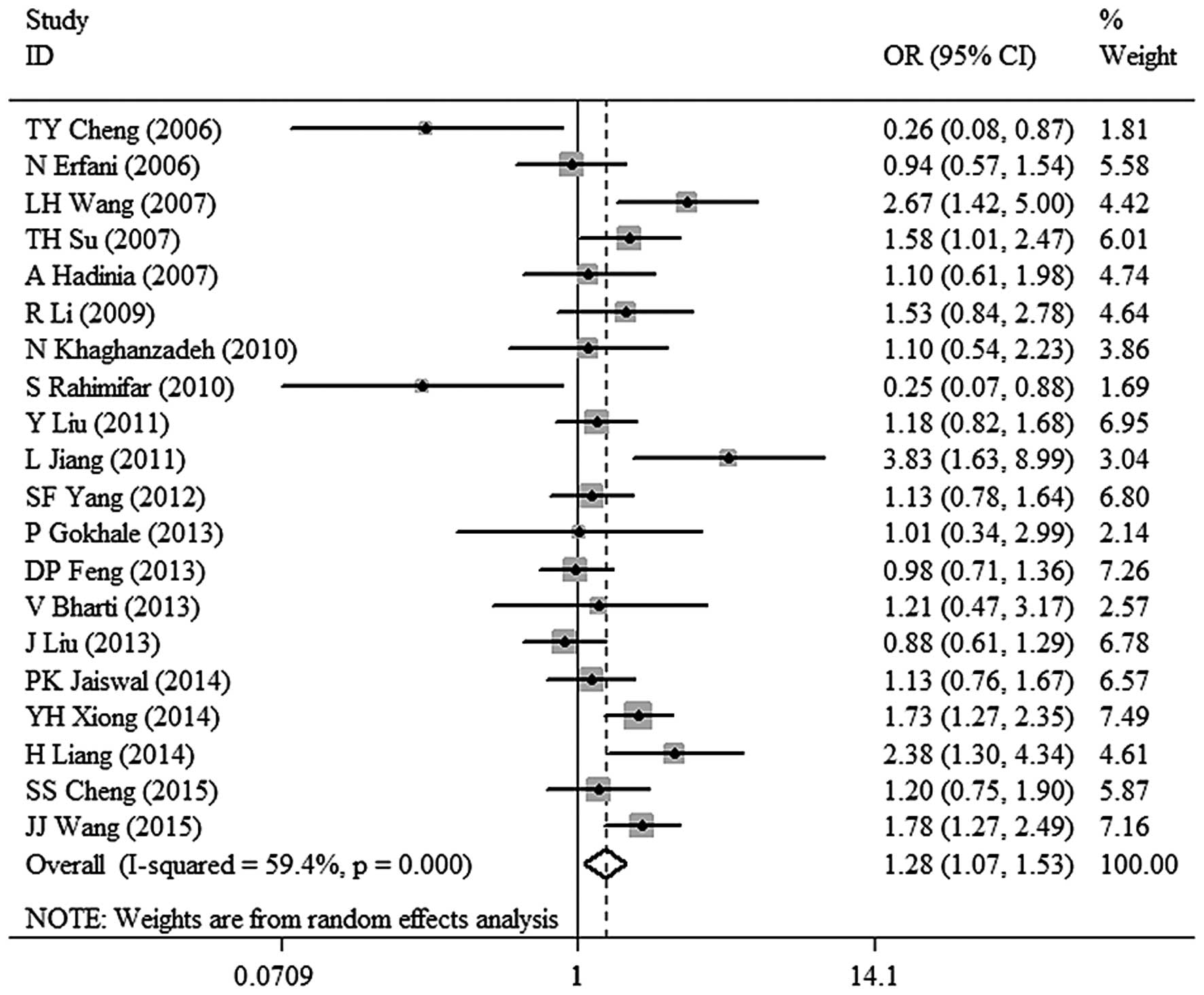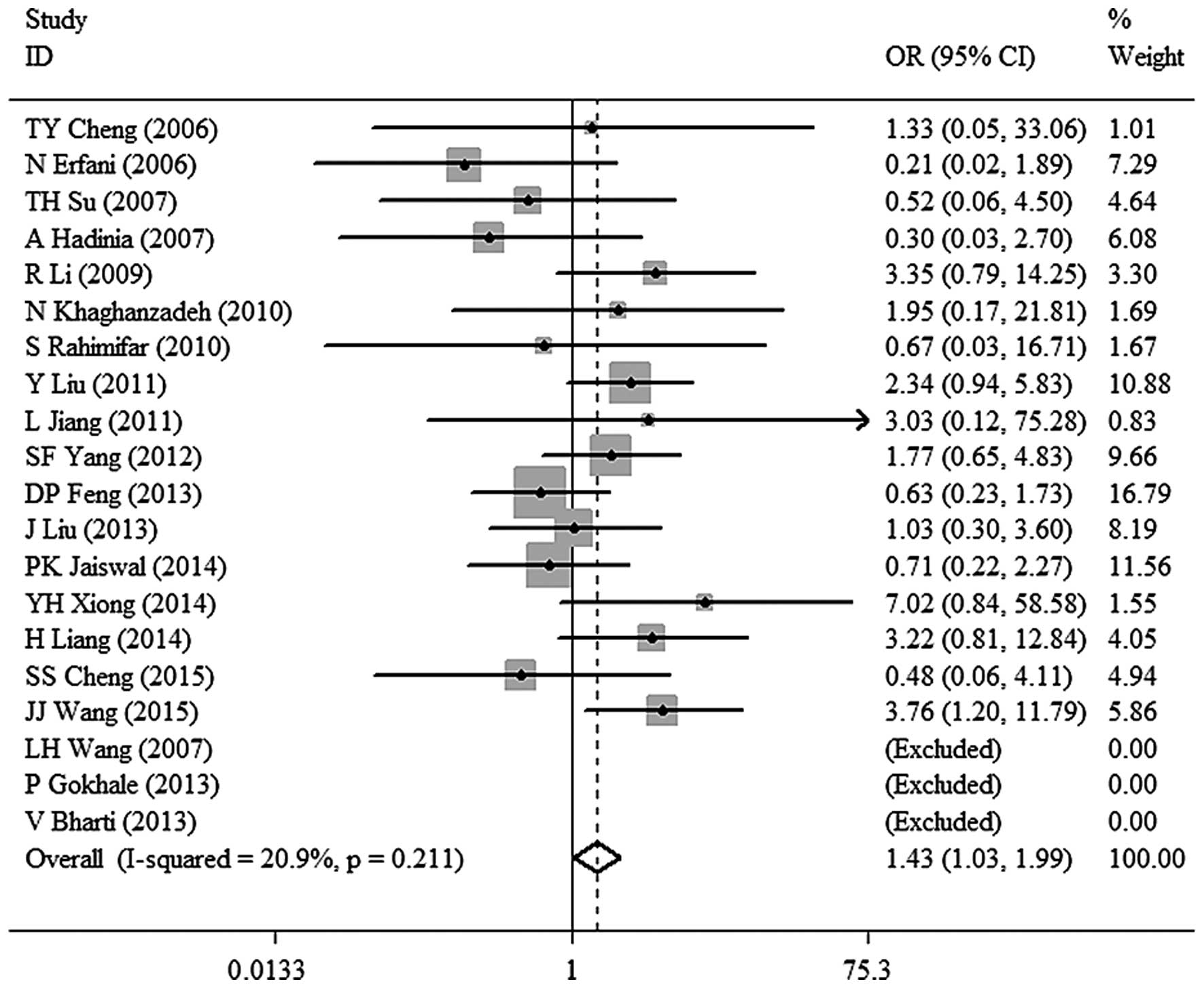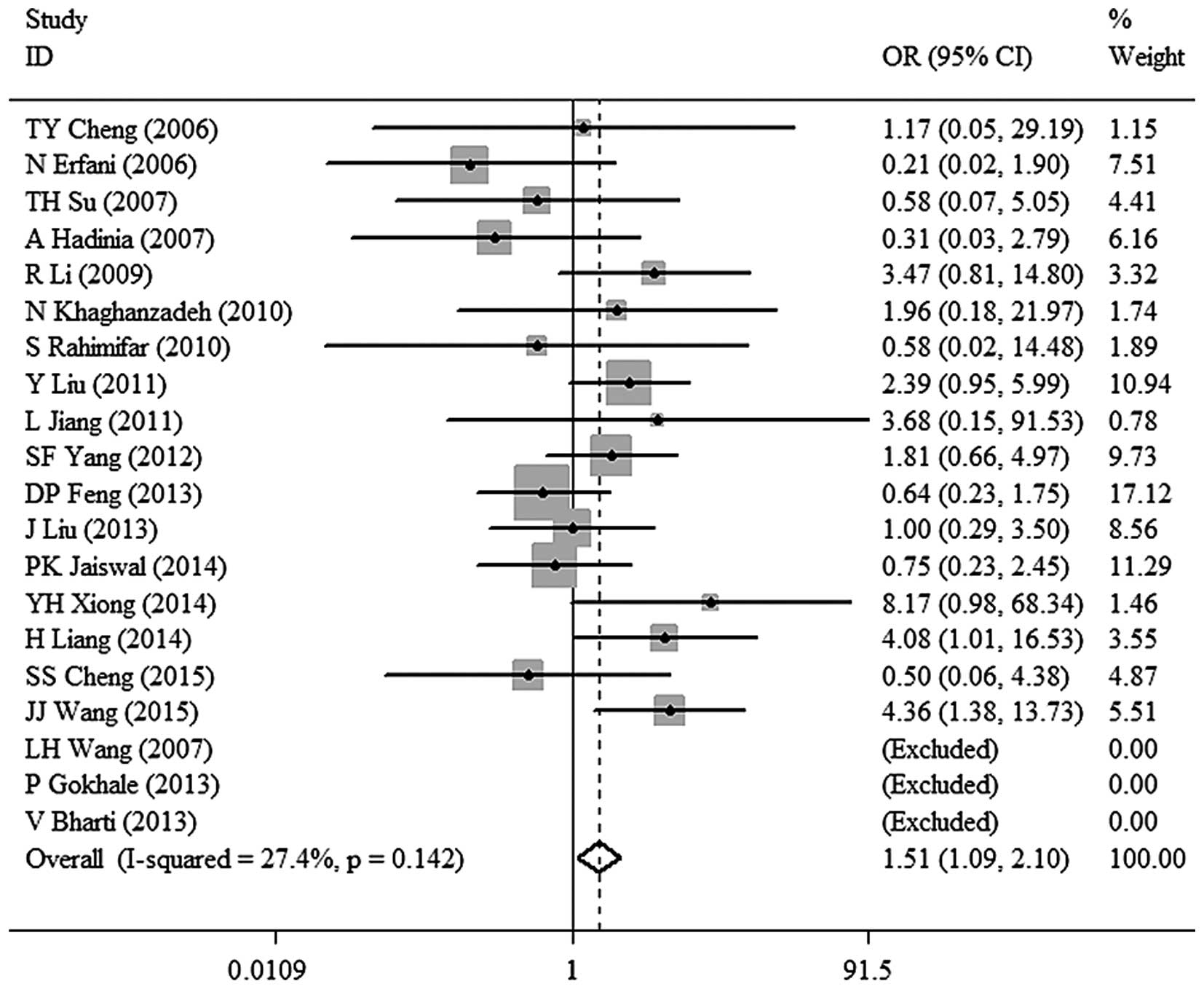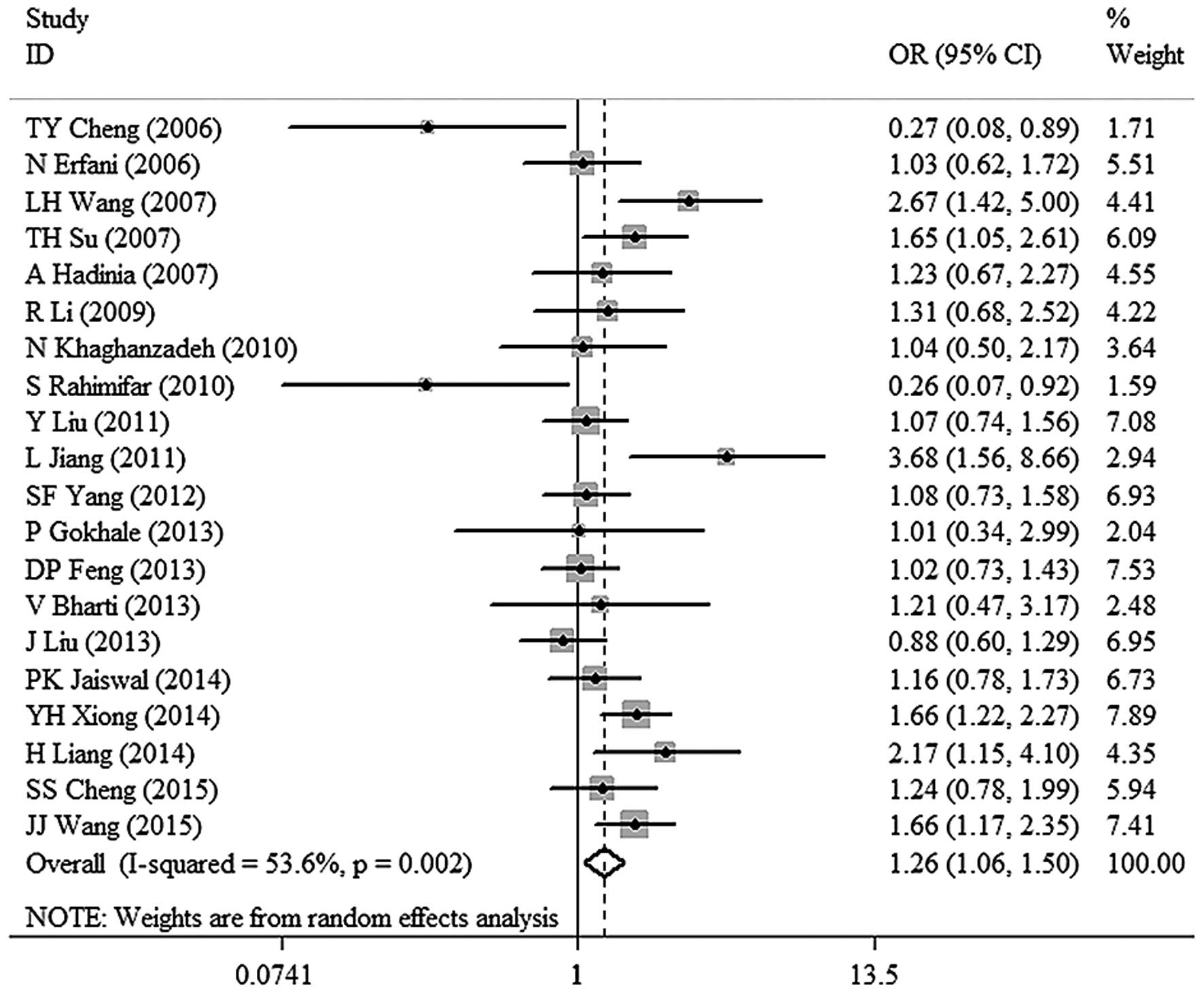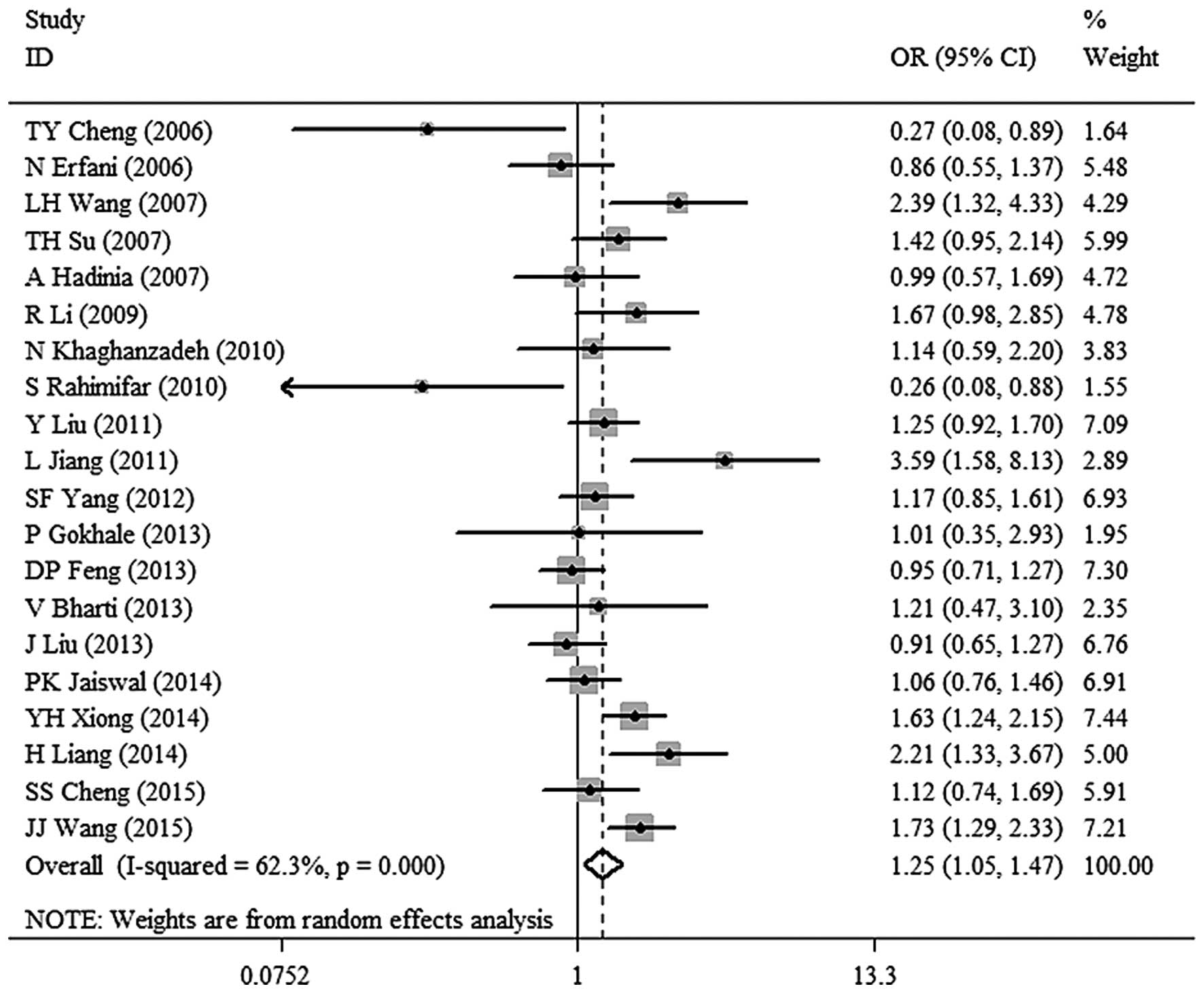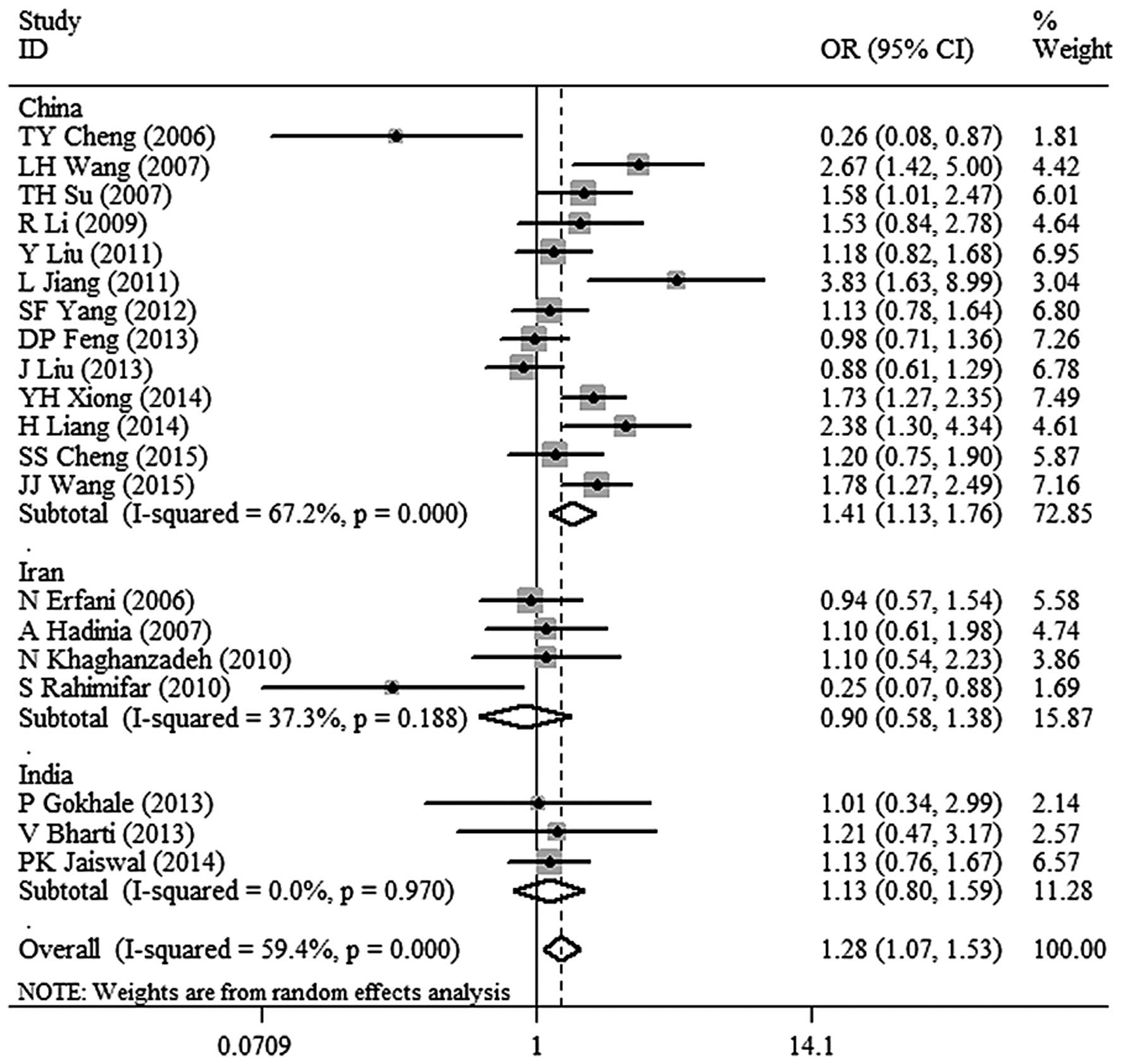Association between the cytotoxic T-lymphocyte antigen 4 -318C/T polymorphism and malignant tumor risk
- Authors:
- Published online on: May 19, 2016 https://doi.org/10.3892/br.2016.683
- Pages: 93-100
Abstract
Introduction
Malignant tumors are a complex disease relating to an interaction effect between polygenic inheritance and environmental factors (1). Tumorigenesis and the development of malignant tumors are poorly understood, and further research is required concerning their key underlying factors and molecular abnormalities. In recent years, the response of the immune system to malignant tumors has been the focus of investigation (2). Studies on the role of T lymphocytes and natural killer cells in mediating an antitumor response have been increasing in recent years (3). For this reason, genetic polymorphisms of the genes involved the mediate response of T lymphocytes have been investigated for a possible association with the risk of developing a range of malignant tumors (4,5). One of these genes, cytotoxic T-lymphocyte-associated antigen 4 (CTLA-4), located on chromosome 2q33, is a member of the immunoglobulin superfamily and has an important role in the regulation of T-lymphocyte activation and proliferation (6). CTLA-4 polymorphisms have been demonstrated to be associated with increased susceptibility to various malignant tumors in a number of different ethnic populations. Previous studies have been performed to determine whether the −318 cytosine/thymine (−318C/T) polymorphism was involved in the etiology of various malignant tumors in Asian population (7–26). However, the results from these studies remain inconclusive and conflicting. The present study aimed to achieve a more precise assessment of the association between CTLA-4 −318C/T polymorphism and malignant tumor risk in an Asian population by performing a meta-analysis on 20 eligible case-control studies to estimate the CTLA-4 −318C/T polymorphism and malignant tumor.
Materials and methods
Literature search
The PubMed, Embase, Chinese Journals Full-Text Database, Chinese Biomedical Database, and Wanfang databases were searched for all articles published up to September 30, 2015. The literature search used a number of keywords including, ‘genetic polymorphism’, ‘cancer OR carcinoma’, and ‘cytotoxic T-lymphocyte antigen-4 OR CTLA-4’. No language restrictions were applied. All of the eligible studies included in the meta-analysis had to meet the following inclusion criteria: i) Evaluation of the CTLA-4 −318C/T polymorphism and malignant tumor risk; ii) independent case-control study in design; iii) available data (distribution of alleles and genotypes for cases and controls) estimating an odds ratio (OR) with a 95% confidence interval (95% CI) of CTLA-4 −318C/T gene polymorphisms in both cases and controls; iv) the studies on Asian population; and v) genotype distributions in the controls conformed to the Hardy-Weinberg equilibrium (HWE). The following exclusive criteria were used: i) Repeat or overlapping publications; ii) abstracts, reviews or letters; and iii) studies in which genotype frequencies were not reported.
Data extraction
To enhance credibility and reduce bias in the study, all data were abstracted by two of the authors independently, who complied with the rigorous selection criteria and reached a consensus on all items. The following information was extracted from each study: First author, year of publication, ethnicity and country of origin, type of malignant tumor, sample size, and HWE evidence in controls (Table I).
Statistical analysis
The ORs with corresponding 95% CIs were calculated for the strength of correlations between CTLA-4 −318C/T gene polymorphisms and malignant tumor risks in an Asian population. The significance of the pooled OR was determined by using a Z-test, and P<0.05 was considered to indicate a statistically significant difference. In order to assess the association between CTLA-4 −318C/T polymorphism and malignant tumor risk, five genetic models were used to evaluate the pooled ORs of the polymorphism, as follows: Dominant model (TT+TC vs. CC), recessive model (TT vs. TC+CC), homozygous model (TT vs. CC), heterozygous model (TC vs. CC), and allele model (T vs. C) for −318C/T. The OR was calculated by using different effect models according to the result of heterogeneity test. The statistical heterogeneity of studies was checked by using the Chi-square-based Q statistic: When P≥0.05, the fixed-effects model (Mantel-Haenszel method) was used to analyze the data, whereas the random-effects model (the DerSimonian and Laird method) was used if P<0.05 (27). In addition, the I2 test was used, and was considered statistically significant at an I2 value ≥50%, and the random-effects model was performed. An I2 value <50% indicates lack of heterogeneity, and therefore the fixed-effects model was used. Through an initial screen of the results, the majority of the included populations were identified as originating from China, hence a subgroup meta-analyses was also performed. The subgroup meta-analyses were conducted by comparing the China population with the population from the rest of Asia for the −318C/T polymorphism. We checked publication bias by visual inspection of asymmetry in funnel plots. In addition, Egger's test was investigated to further evaluate the symmetry of the funnel plot and P<0.05 was considered to indicate a statistically significant difference. All statistical tests were performed using STATA version 11.2 (Stata Corp., College Station, TX, USA).
Results
Study selection and characteristics
A total of 357 results were preliminarily identified to meet the inclusion criteria of the present study. Through an initial screening of titles, key words and abstracts, 329 of these search results were excluded (101 were duplicates; 33 were reviews; 48 were letters, conferences or meta-analysis; 75 were not focused on the CTLA-4 −318C/T polymorphism; 47 were not relevant to malignant tumors, and 25 were not researching an Asian population). A total of 28 full-text studies were then reviewed and an additional 8 studies were excluded for not being a case-control study. Thus, 20 articles with a total of 3,539 cases and 4,690 controls were included in the final data extraction (7–26). There were two articles that analyzed two cancer types (colorectal cancer and gastric cancer) using the same control group (11,12). We combined the two cancer types into one (gastrointestinal cancer), and therefore, the two case-controlled studies were combined. Finally, there were 20 case-controlled studies included in the meta-analysis, Fig. 1 shows the detailed procedure for screening eligible studies. The publication years ranged from 2006 to 2015. Among the 20 case-controlled studies, 13 evaluated the relevant correlation in a Chinese population (7,9,10,12,15–17,19,21,23–26), 4 studies in an Iranian population (8,11,13,14), and 3 researched an Indian population (18,20,22). All enrolled studies showed that the genotypes in the healthy control group did not deviate from the HWE, (all P>0.05). The characteristics of each study are listed in Table I, and the distributions of genotypes and alleles in CTLA-4 −318C/T polymorphisms are listed in Table II.
Table II.Distributions of genotypes and alleles in cytotoxic T-lymphocyte antigen 4 −318C/T polymorphisms. |
Quantitative synthesis
The summary of results from the meta-analysis of the association between CTLA-4 −318C/T polymorphisms and malignant tumor in Asian populations is shown in Table III. The heterogeneity of the dominant model (TT+TC vs. CC), heterozygous model (TC vs. CC) and allele model (T vs. C) were performed for the 20 case-controlled studies and there was statistical heterogeneity among these models (Table III). However, the heterogeneity of the recessive model (TT vs. TC+CC) and homozygous model (TT vs. CC) were performed for 17 case-control studies (there were three case-control studies excluded by the STATA software automatically for lack of homozygote genotype TT both in cases and controls) and there was no statistical heterogeneity in the two models (Table III). Data from the meta-analysis for TT+TC vs. CC was as follows: χ2, 46.84; df=19; P=0.0004 and I2=59.4%. A random-effects model was used to analyze the data. A significant association between CTLA-4 −318C/T polymorphism and malignant tumor risk (OR, 1.28; 95% CI, 1.07–1.53; P=0.008) was observed in dominant model (Fig. 2). The results also revealed an association between CTLA-4 −318C/T polymorphism and malignant tumor risk in the Asian population under other models [TT vs. TC+CC: OR, 1.43; 95% CI, 1.03–1.99; P=0.032 (Fig. 3). TT vs. CC: OR, 1.51; 95% CI, 1.09–2.10; P=0.014 (Fig. 4). TC vs. CC: OR, 1.26; 95% CI, 1.06–1.50; P=0.008 (Fig. 5). T vs. C: OR, 1.25; 95% CI, 1.05–1.47; P=0.010 (Fig. 6)]. In the subgroup analysis, a significant association between CTLA-4 −318C/T polymorphism and malignant tumor risk in the Chinese population was identified (OR, 1.41; 95% CI, 1.13–1.76; P=0.002 for TT+TC vs. CC; Fig. 7). In addition, there was no association between CTLA-4 −318C/T polymorphism and malignant tumor risk in the populations of other countries (Fig. 7).
Publication bias
No publication bias was detected in either the Begg's funnel plot (data not shown) or Egger's test for TT+TC vs. CC (t=−0.64; P>|=0.533). The relative symmetrical distribution for the Begg's funnel plot (data not shown) or Egger's test (t=−0.58; P>|=0.570) indicated there was no publication bias for allele model (T vs. C).
Discussion
In recent years, an increasing number of studies have revealed the effect of gene polymorphisms in tumorigenesis or the susceptibility to malignant tumors. Tumor immunity is increasing as a focus in malignant tumors research. CTLA-4, an important mediator in T cell proliferation and activation, is important in cancer immunosurveillance (28). Previous studies demonstrated that variants of CTLA-4 −318C/T may increase susceptibility to malignant tumors in Asian populations (7,14,29). However, negative results have been reported in a previous study (16). To date, no meta-analysis has been conducted to comprehensively evaluate the association between the CTLA-4 −318C/T polymorphism and malignant tumor risk in Asian populations. Thus, the current study performed a meta-analysis to explore the exact associations between the CTLA-4 −318C/T polymorphism and malignant tumor risk in an Asian population.
The results of our meta-analysis indicated that CTLA-4 −318C/T polymorphism was significantly association with the risk of developing a malignant tumor. The TT+TC genotype and the TC heterozygote carriers exhibited higher malignant tumor incident risks when compared to the CC genotype carriers (TT+TC vs. CC: OR, 1.28; 95% CI, 1.07–1.53; P=0.008. TC vs. CC: OR, 1.26; 95% CI, 1.06–1.50; P=0.008). When the comparisons were conducted between the TT and CC homozygotes or between the T and C alleles, there remained a significant effect from the TT homozygote or the T allele on the risk of malignant tumor, respectively (TT vs. CC: OR, 1.51; 95% CI, 1.09–2.10; P=0.014. T vs. C: OR, 1.25; 95% CI, 1.05–1.47; P=0.010). The analysis reveals that CTLA-4 −318C/T genetic variants may be an important factor in the development and progression of malignant tumors in Asian populations, and individuals with the variant T allele have a ~25% higher risk of developing malignant tumors. In the subgroup analysis, we found that the dominant models (TT+TC vs. CC) had significantly increased the risk of malignant tumor in China (OR, 1.41; 95% CI, 1.13–1.76). In addition, there were no such correlation in Iran and India, indicating that country differences may be a potential factor of heterogeneity for this correlation.
However, the results from current meta-analysis must be interpreted with caution, as some limitations should be considered. First, for the Iran and India study populations, only 5 and 3 case-control studies were included in each, respectively. Second, only published studies in the selected databases were included, and some unpublished studies with null results were ignored. Third, the studies included in the meta-analysis were lacking in original information concerning environmental and lifestyle factors, which prevented us from further performing subgroup analysis according to these variables. All of these limitations may have limited power to reveal a credible association and distort the results. Hence, we addressed the heterogeneity and publication bias through rigorously selecting case-control studies, using a statistical approach to analyze the inconsistent data of selected studies, contributing to a more reliable association between the CTL-4 −318C/T polymorphism and malignant tumor risk in Asian populations. Significant publication bias was not detected for the gene polymorphisms, indicating the reliability of the results from this meta-analysis.
In conclusion, the results from the meta-analysis suggest that the CTL-4 −318 C/T polymorphisms, may be a risk factor for the development of malignant tumors in Asian populations. However, this result should be interpreted with caution, because the eligible studies are only from 3 Asian countries, and the studies contained no more than five individuals, except for those originating from China. A subgroup analysis was performed by country, and the dominant model (TT+TC vs. CC) revealed a significantly increased risk of malignant tumors in the Chinese population (OR, 1.41; 95% CI, 1.13–1.76; P=0.002). However, the analysis did not reveal any association between CTL-4 −318 C/T polymorphisms and the risk of malignant tumor in the Iranian and Indian populations. The fact that there were not sufficient numbers of studies from other Asian nations may distort our conclusion. More intensive studies based on individuals from additional countries in Asia are required to further reveal the precise association between CTL-4 −318C/T polymorphisms and malignant tumor risk in Asian populations.
References
|
Bredberg A: Cancer: More of polygenic disease and less of multiple mutations? A quantitative viewpoint. Cancer. 117:440–445. 2011. View Article : Google Scholar : PubMed/NCBI | |
|
Wong YK, Chang KW, Cheng CY and Liu CJ: Association of CTLA-4 gene polymorphism with oral squamous cell carcinoma. J Oral Pathol Med. 35:51–54. 2006. View Article : Google Scholar : PubMed/NCBI | |
|
Ramakrishnan R and Gabrilovich DI: Novel mechanism of synergistic effects of conventional chemotherapy and immune therapy of cancer. Cancer Immunol Immunother. 62:405–410. 2013. View Article : Google Scholar : PubMed/NCBI | |
|
Zhang Y, Zhang J, Deng Y, Tian C, Li X, Huang J and Fan H: Polymorphisms in the cytotoxic T-lymphocyte antigen 4 gene and cancer risk: A meta-analysis. Cancer. 117:4312–4324. 2011. View Article : Google Scholar : PubMed/NCBI | |
|
Ghaderi A: CTLA4 gene variants in autoimmunity and cancer: A comparative review. Iran J Immunol. 8:127–149. 2011.PubMed/NCBI | |
|
Sun T, Zhou Y, Yang M, Hu Z, Tan W, Han X, Shi Y, Yao J, Guo Y, Yu D, et al: Functional genetic variations in cytotoxic T-lymphocyte antigen 4 and susceptibility to multiple types of cancer. Cancer Res. 68:7025–7034. 2008. View Article : Google Scholar : PubMed/NCBI | |
|
Cheng TY, Lin JT, Chen LT, Shun CT, Wang HP, Lin MT, Wang TE, Cheng AL and Wu MS: Association of T-cell regulatory gene polymorphisms with susceptibility to gastric mucosa-associated lymphoid tissue lymphoma. J Clin Oncol. 24:3483–3489. 2006. View Article : Google Scholar : PubMed/NCBI | |
|
Erfani N, Razmkhah M, Talei AR, Pezeshki AM, Doroudchi M, Monabati A and Ghaderi A: Cytotoxic T lymphocyte antigen-4 promoter variants in breast cancer. Cancer Genet Cytogenet. 165:114–120. 2006. View Article : Google Scholar : PubMed/NCBI | |
|
Wang L and Li D, Fu Z, Li H, Jiang W and Li D: Association of CTLA-4 gene polymorphisms with sporadic breast cancer in Chinese Han population. BMC Cancer. 7:1732007. View Article : Google Scholar : PubMed/NCBI | |
|
Su TH, Chang TY, Lee YJ, Chen CK, Liu HF, Chu CC, Lin M, Wang PT, Huang WC, Chen TC, et al: CTLA-4 gene and susceptibility to human papillomavirus-16-associated cervical squamous cell carcinoma in Taiwanese women. Carcinogenesis. 28:1237–1240. 2007. View Article : Google Scholar : PubMed/NCBI | |
|
Hadinia A, Hossieni SV, Erfani N, Saberi-Firozi M, Fattahi MJ and Ghaderi A: CTLA-4 gene promoter and exon 1 polymorphisms in Iranian patients with gastric and colorectal cancers. J Gastroenterol Hepatol. 22:2283–2287. 2007. View Article : Google Scholar : PubMed/NCBI | |
|
Li R, Xia B, Xiao H, Jiang Y and Zhou F: Association between CTLA-4 gene promoter region polymorphisms at positions −1661 and −318 and gastric cancer. Clin J Gastroenterol. 14:332–336. 2009. | |
|
Khaghanzadeh N, Erfani N, Ghayumi MA and Ghaderi A: CTLA4 gene variations and haplotypes in patients with lung cancer. Cancer Genet Cytogenet. 196:171–174. 2010. View Article : Google Scholar : PubMed/NCBI | |
|
Rahimifar S, Erfani N, Sarraf Z and Ghaderi A: ctla-4 gene variations may influence cervical cancer susceptibility. Gynecol Oncol. 119:136–139. 2010. View Article : Google Scholar : PubMed/NCBI | |
|
Liu Y, He Z, Feng D, Shi G, Gao R, Wu X, Song W and Yuan W: Cytotoxic T-lymphocyte antigen-4 polymorphisms and susceptibility to osteosarcoma. DNA Cell Biol. 30:1051–1055. 2011. View Article : Google Scholar : PubMed/NCBI | |
|
Jiang L, Luo RY, Zhang W, Wang LR, Wang F and Cheng YX: Single nucleotide polymorphisms of CTLA4 gene and their association with human cervical cancer. Zhonghua Yi Xue Yi Chuan Xue Za Zhi. 28:313–317. 2011.(In Chinese). PubMed/NCBI | |
|
Yang S, Wang C, Zhou Y, Sun G, Zhu D and Gao S: Cytotoxic T-lymphocyte antigen-4 polymorphisms and susceptibility to Ewing's sarcoma. Genet Test Mol Biomarkers. 16:1236–1240. 2012. View Article : Google Scholar : PubMed/NCBI | |
|
Gokhale P, Kerkar S, Tongaonkar H, Salvi V and Mania-Pramanik J: CTLA-4 gene polymorphism at position +49 A>G in exon 1: A risk factor for cervical cancer in Indian women. Cancer Genet. 206:154–161. 2013. View Article : Google Scholar : PubMed/NCBI | |
|
Feng D, Yang X, Li S, Liu T, Wu Z, Song Y, Wang J, Gao W, Huang Q, Huang W, et al: Cytotoxic T-lymphocyte antigen-4 genetic variants and risk of Ewing's sarcoma. Genet Test Mol Biomarkers. 17:458–463. 2013. View Article : Google Scholar : PubMed/NCBI | |
|
Bharti V, Mohanti BK and Das SN: Functional genetic variants of CTLA-4 and risk of tobacco-related oral carcinoma in high-risk North Indian population. Hum Immunol. 74:348–352. 2013. View Article : Google Scholar : PubMed/NCBI | |
|
Liu J, Liu J, Song B, Wang T, Liu Y, Hao J and Yu J: Genetic variations in CTLA-4, TNF-α, and LTA and susceptibility to T-cell lymphoma in a Chinese population. Cancer Epidemiol. 37:930–934. 2013. View Article : Google Scholar : PubMed/NCBI | |
|
Jaiswal PK, Singh V and Mittal RD: Cytotoxic T lymphocyte antigen 4 (CTLA4) gene polymorphism with bladder cancer risk in North Indian population. Mol Biol Rep. 41:799–807. 2014. View Article : Google Scholar : PubMed/NCBI | |
|
Xiong YH, He L and Fei J: Genetic variations in cytotoxic T-lymphocyte antigen-4 and susceptibility to cervical cancer. Int Immunopharmacol. 18:71–76. 2014. View Article : Google Scholar : PubMed/NCBI | |
|
Hui L, Lei Z, Peng Z, Ruobing S and Fenghua Z: Polymorphism analysis of CTLA-4 in childhood acute lymphoblastic leukemia. Pak J Pharm Sci. 27(Suppl 4): 1005–1013. 2014.PubMed/NCBI | |
|
Cheng S, Li J, Liu W, Liu C, Su L, Liu X, Guo L, Ma Y, Song B and Liu J: LTA + 252A > G polymorphism is associated with risk of nasal NK/T-cell lymphoma in a Chinese population: A case-control study. BMC Cancer. 15:4802015. View Article : Google Scholar : PubMed/NCBI | |
|
Wang JJ, Wang ZB and Huang WF: The correlation of cytotoxic T lymphocyte antigen 4 polymorphisms with occurrence of cervical cancer. Pract J Clin Med. 12:77–80. 2015. | |
|
Jackson D, White IR and Riley RD: Quantifying the impact of between-study heterogeneity in multivariate meta-analyses. Stat Med. 31:3805–3820. 2012. View Article : Google Scholar : PubMed/NCBI | |
|
Leach DR, Krummel MF and Allison JP: Enhancement of antitumor immunity by CTLA-4 blockade. Science. 271:1734–1736. 1996. View Article : Google Scholar : PubMed/NCBI | |
|
Xu HB, Yang H, Liu T and Chen H: Association of CTLA4 gene polymorphism (rs5742909) with cervical cancer: A meta-analysis. Tumour Biol. 35:1605–1608. 2014. View Article : Google Scholar : PubMed/NCBI |



